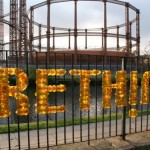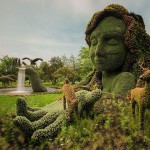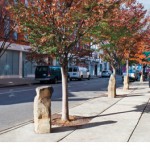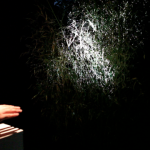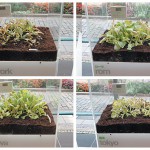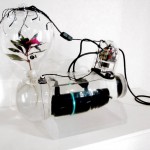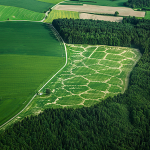Visualize data and stories with plants

On my last blog post "Can plants be a music interface" I explored plants as a possible input channel for musical devices. This time, I want to explore plants as a kind of display. Especially, how artists, designers, and engineers can communicate their data and stories through plants. More than a few plant based narrative approaches exist in our culture. They are mostly connected with old traditions and rituals. For instance, the Christmas tree or the Harvest festival (picture) are very common rituals for us. In this article I strongly focus on (Fine) Arts and Design approaches than on ritual driven expressions. The first part is more Fine Art and analog (without technology) oriented and the second part focuses on Design approaches with the support of Technology.
**** UPDATE NEW VERSION HERE ****
Fine Art approaches without Media Technology
The leaf is very basic piece of our natural ecosystem. Plenty of them exist in different shapes and materials. Lorenzo Manuel Durán is a master of using them in a stencil oriented approach. He creates amazing pictures inside the shape of a leaf (Works: Chapter 2 | 3 | 5 | 6 | 7 | 8). Furthermore, Anna Garforth uses leaves for a bigger Typograhpy oriented installation "Rethink". It seems she shifted her approach of working with leaves to moss (Grow | Big Bang). Moss is very practical material because it is able to live on walls and it is easy to shape. For this reason, it fits perfectly in urban environments. Besides this, the Vertical Garden approach is used more and more often by architects for creating green walls. Engineers, Designers, and the DIY community (video) discovered this approach for themself.
Aside from that more or less small to mid size 2D surface approaches, the sculpture and installation domain reveal also some interesting approaches. Especially, Azuma Makoto is a great artist for Plant Sculptures. One of his masterpieces "Collapsible leaves" is a great example of plant sculptures in the domain of interior design. In relation to environmental design, the Montreal Mosaiculture Exhibition (book) presents some amazing artworks of Plant Sculptures. In the connection of installations and narratives, the so called "Plant Display" approach, is pretty interesting, too. A Plant Display (instructions) combines a collection of plants in a specific arrangement. It is very similar to the Japanese tradition Ikebana, which involves the narrative aspects of plant arrangement. Furthermore, plants can be used for creating fictional subspaces, like Banksy recently did in New York (article | video). This kind of subspaces inside a natural, urban, or interior environment, I would like to call it: Plant Installations. Plant Installations are usually bigger than sculptures and they bridge the gap between Gardening (see example 1 | 2) and Land Art / Landscape Architecture.
Land Art can exist anywhere outside. The size of the artworks ranges from mid-size to very large installations. For instance, the artwork 7,000 oaks by Joseph Beuys is installed through the entire city Kassel, Germany. The very well known Crop circles are in a size of a crop field. The real beauty of these artworks can be mostly perceived from air or other high positions. The artwork "Trümmerflora" by Harrison had its place on an abandoned area in Berlin. The artworks by Nils-Udo are very often located in a forest or other natural environments (e.g. parks). He combines the sculpture and environmental design approaches in one artwork. I don't want to report more about Land Art, because it deserves an article all by itself. The artistic practices of Land Art give us an insight and feeling, how we can integrate ubiquitous computing technology into natural environments without destroying its natural look and feel.
In a summary, the mentioned art approaches have definitive a narrative character, or at least they are able to present information units. Additionally, all these artworks belong to the domain of Living Sculptures. They are dynamic and have got a very sensitive life cycle. For this reason, time has a large influence into these artworks, than other fine artworks have. Time is always an important conceptual design medium for these kinds of artworks.
Design approaches with Media Technology
This chapter explores visualizations on or through plants. All of these mentioned artworks are somehow connected with media technology. The most projects visualize a state, a value, or a bunch of information units. For this reason, the research will be interesting for interactive art installations and information design.
Last couple of years, scientists had worked very hard for connecting the physical world with digital world. In our current daily life we accomplish this connection through scanning QR-Codes and other physical markers (e.g. images, RFID chips etc.) with the smart phone. The Augmented Reality project LEAF++ uses instead of the common markers the shape and structure of a leaf. They created a social network based on these leaves. The users of this network can assign digital data to a leaf and enrich their environment (video). A combination of patterns inside a leaf, how Lorenzo Manuel Durán does, would be a nice extension to make the recognition system more stable. The result could be a leaf based physical marker, which combines the famous ARToolkit marker concept with their own marker characteristic. However, just my thoughts...
We all know that plants can't change their location, but everybody knows they can move. Even a weak wind causes leaves and branches of a tree to vibrate. Kent Wilson uses the plant ability of vibrating for his artwork "The Mediated Body of Plants" (Prototyp). The plant has two kinetic gestures: wave and shudder. The level of soil moisture causes the plant waving or shuddering. Two motors execute the gestures. One motor under the plant’s pot and the other motor vibrates the plant’s stem. These kinetic gestures are very easy for our human perception to recognize. It is a good tool for attracting attention. The HCI project Tsunagari kan - FamilyPlant (paper) takes advantage of this kinetic approach as well. The artificial plant rotates for visualizing a human motion level in a room. Very similiar to the "Flona"(paper) project of the Keio University. Their prototyp supports a wider range of movements to convey emotions. Their installations is able to move several branches independently from each other. This allows to represent a bigger amount of information.
Besides the kinetic gestures of a plant, they also have a surface. For me as a new media boy, it is impossible not to mention the techniques of Projection Mapping. Projection Mapping is often used in an architectural context. The elements of building's facades are integrated into these motion graphics. Some artists applied this technique on plants. For instance, Clement Briend created a nice projection series "Cambodian Trees" (video). Craig Walsh is another artist, who involves the structure of a tree as a texture for his projection mapping "Spacemakers". Beyond the use of leaves, the branches deliver a nice structure and surface. The installation "Lit tree" by the art collective Kimchi and chips enhances the concept of projection mapping. Their installation measures motion areas and visualize it on a bush. The areas, which get the most light, grow better than the others with less light. In this relation the growing process of the plant is synchronized with motion detection data of the digital sensors system. From a gedankenexperiment view, the digital motion data is stored and translated to a plant physiology.
The idea of using the growing process of a plant for visualizing data is not new. For this reason, Satoshi Kuribayashi and Akira Wakita developed the concept of Growable Media Design. This includes the monitoring and accurate control sustenance of a plant. The plant’s growing process can be influenced in different ways. As mentioned previously, light can be one factor. The interactive art installation "Dialog" by Terike Haapoja uses light for revealing the interactions between humans and the tree. He measures the exhaled CO2 level and depending on that level the tree gets more or less light. The size of the tree shows how much CO2 the tree consumed. The project "The Garden of Eden"(paper) uses air as a factor. The air pollution of each G8's capital is visualized in the plant health of a salad. Depending on the latest air pollution level the salad gets surrounded by better or worse air quality. The installation "Plant Display" by Satoshi Kuribayashi and Akira Wakita uses water as an influence factor for the growing process. The water and nutrient supply depends on the mobile communication activity of one person. Similar to the narrative aspects of the Bonsai culture, the plants visualize some sort of human relation and feelings. Growing Plants without soil and only with water is a very common approach of industrial food production. Phil Ross transferred this approach of hydro culture to the Fine Arts World. His installations "Jarred-In", "Juggernaut" mastered the use of hydro culture for natural oriented sculptures. The artwork "Junior Return" takes advantage of hydro culture, too. The supply of the nutrients with water is much more easier to control, than the traditional nutrient supply with soil. For this reason, hydro culture is the recommended approach for Growable Media Design projects. In this context, "Junior Return" is a great example of using light and water (hydro culture) as a combination factor for plant growing. The artwork "Yucca Invest Trading Plant" by Ola Pehrson uses instead the traditional approach with soil + water and light. The growing process is synchronized with the performance of the trading.
So far we have got in touch with growing factors light, air, water, nutrients and fertilizer. As far as I know there exist only two artworks that uses all of these factors in one piece. The artwork is called "Anatomy of a Landscape" by Terike Haapoja and looks like a landscape painting from a wide distance. But if you look at it from a close distance you can recognize that it is a Vivarium with its own ecosystem and living plants. The lifecycyle of the plants defines the look and feel of this artwork. In my opinion it is a great implementation of a dynamic painting / sculpture. The "Paludarium SUGURU" by Azuma Makoto is very sculpture oriented artwork and an example par excellence of a living sculpture.
None of these mentioned artworks use negative factors. It is possible to add negative factors to a plant's growing process. For instance, it would be possible to poison the plant if you want to visualize a strong impact of your data. People react very emotional to plants. Therefore the concept should be very well considered, before you use this strong design medium for your project.
After all these very sculpture oriented and small to mid-sized projects, the artist Benedikt Groß applied his knowledge of Generative Art to Land Art. His approach of Agricultural printing with the project name "Avena+ Test Bed" uses Farming Technology for printing patterns and structures on a field (see blog). These geometry patterns are very close to Crop circles. Instead of human created patterns, an algorithm controlled machine decides the sort and the density of seeds. After some time you can recognize a large scale 2d structure on the field. The technique can be used for communicate small information, which are perceived from a higher point of view. Another positive aspect is the supported biodiversity through this approach.
Summary
The purpose of this research is getting a feeling about the "plants as a display" questions:
- what kind of data can be visualized?
- in which size amd shape can it be visualized?
For visualizing accurate messages and data, it is only possible to use a very static approach of plant sculptures, like Anna Garforth does, or some kind of kinetic gestures for communication different states of information.
In relation to the Japanese traditions Ikebana and Bonsai, it becomes obvious that plants can communicate data and stories, which have an interpretive character. Especially, when the content is related to emotional stories and data, plants are a good choice. People have a very strong emotional connection to plants, because they are living creatures.
Furthermore, plants hold a dynamic characterstic. Their lifecycle and lifetime enable artists to embed time-based data and stories. Nowadays only electronic screens have the ability to present such dynamic content. They are capable to change their content very fast. In comparison to this, plants grow pretty slow and can't change their experience so fast. In spite of all that they are very good in memorizing mid to long term data. For instance, Dendrochronology is a very common tool for analyzing ecology data from a local environment. Why not using this kind of ability for visualizing mid to long term data with plants?! The project "Plant Display" and "Yucca Invest Trading Plant" are great examples of this approach.
The size and shape of plants can range from small sculptures to large-scale environmental installations. In this context, plants are not appropriate for visualizing a huge amount of different data sets. They are appropriate for visualizing a specific value inside an interior environment or outdoor environment. These arguments make plants, as a material, very interesting for Ubiquitous Computing and Internet of Things projects. Plants are able to be integrated in our current media technology. They have positive impact on human's well-being and connect us more with nature. The current media technology evolves more in opposite direction instead of combining humans with nature again.


